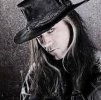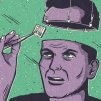Description: Dark jazz is a subgenre that blends elements of jazz with darker, more atmospheric sounds, often incorporating influences from genres like ambient, doom metal, and experimental music. Here are some key characteristics of dark jazz:
**Atmospheric Soundscapes**: Dark jazz often creates immersive soundscapes that evoke a sense of melancholy and introspection. This is achieved through the use of reverb, echo, and layered instrumentation.
**Instrumentation**: Typical instruments include saxophone, trumpet, piano, and double bass, often accompanied by electronic elements or unconventional instruments. The arrangements can be sparse or richly textured, depending on the mood.
**Improvisation**: Like traditional jazz, dark jazz frequently features improvisation. Musicians may explore dissonant harmonies and unconventional rhythms, creating a sense of unpredictability.
**Lyrical Themes**: While many dark jazz pieces are instrumental, those that include vocals often explore themes of existentialism, despair, and the human condition, adding to the overall somber atmosphere.
**Influence of Film Noir**: Dark jazz is often associated with the aesthetics of film noir, incorporating cinematic qualities that evoke suspense and intrigue. This connection to visual art enhances its emotional impact.
**Fusion with Other Genres**: Dark jazz often merges with other styles, such as post-rock, ambient, and even metal, resulting in a diverse range of sounds that can vary widely from one artist to another.
Overall, dark jazz is characterized by its ability to evoke deep emotions and create hauntingly beautiful soundscapes, making it a unique and compelling genre for listeners seeking a more introspective musical experience.
-
 carlmcoy
Great
carlmcoy
Great
-
 HYPNAS
Very good Idea !!!
HYPNAS
Very good Idea !!!
-
 HYPNAS
Thanks DS for this great band underrated at the time like
HYPNAS
Thanks DS for this great band underrated at the time like
-
 blacksmith75
Great DS !!!!
blacksmith75
Great DS !!!!
-
 HYPNAS
Momerath is one of the essential bands of the Parisian scene
HYPNAS
Momerath is one of the essential bands of the Parisian scene
-
 ElectroDevil
Cheers! Many thanks for the feature, it's much appreciated.
ElectroDevil
Cheers! Many thanks for the feature, it's much appreciated.
-
 harpagon21
Bien ahi , Admin tendra este EP por favor
harpagon21
Bien ahi , Admin tendra este EP por favor
-
 DaPitimann
Please reload
DaPitimann
Please reload
-
 gweilojake
Great feature, DS....really encourages discovery. Thanks!
gweilojake
Great feature, DS....really encourages discovery. Thanks!
-
 admin
A small update on the site: now you can view a list of
admin
A small update on the site: now you can view a list of
View more »